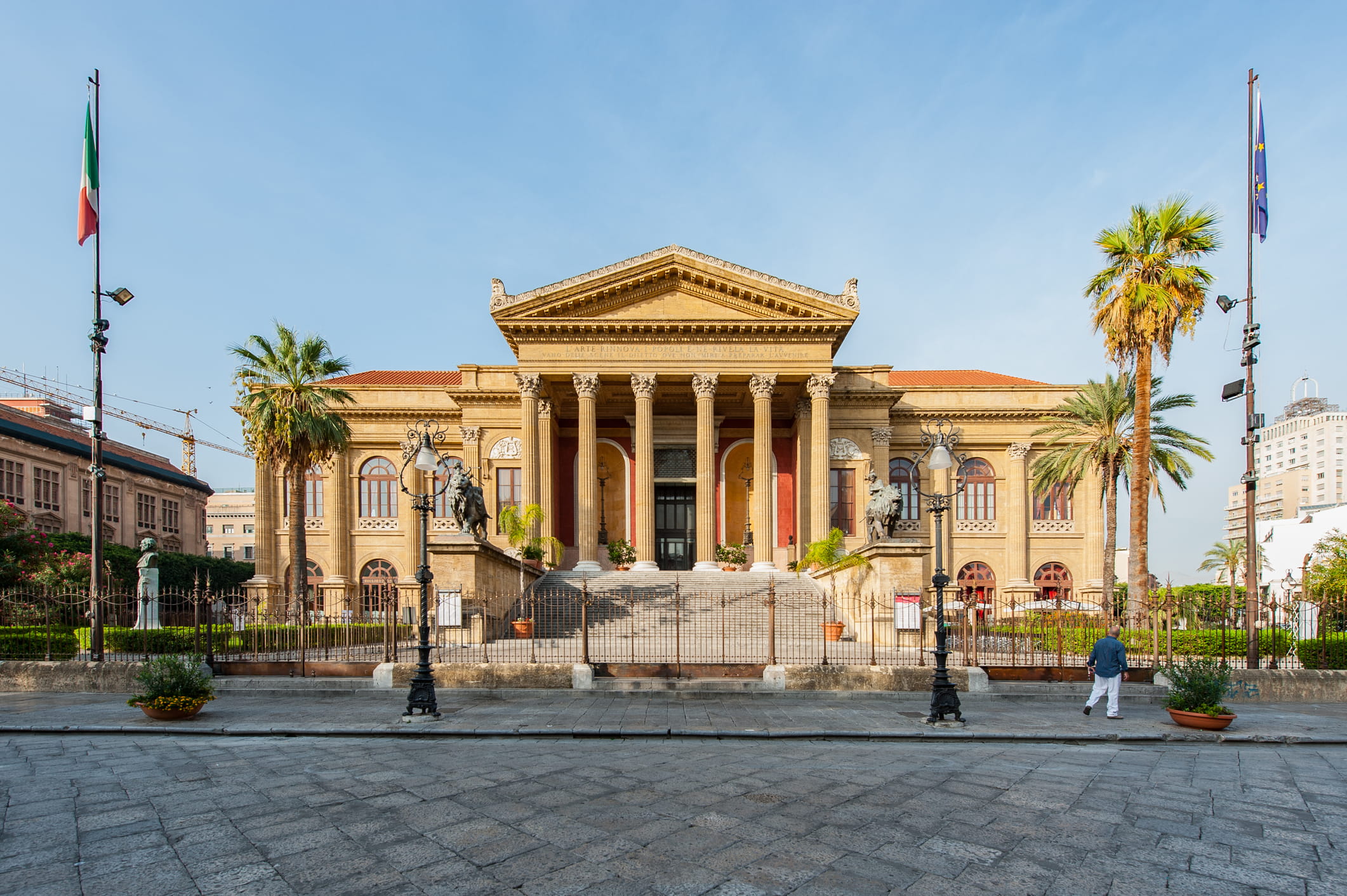Whether you are an art lover or a history buff, whether you want to enjoy good food, the crystal-clear sea, amazing views or are just itching to get to know a great people, I am fairly sure that over recent years Palermo has been pretty near the top of your wish list of places to visit as soon as you possibly can.
For around five years now, the boom that arose out of the regeneration of its old town and resulting selection of various airlines to make it one of the top destinations has led to a tourist invasion of the Sicilian capital like never before.
Palermo has a host of iconic symbols and places and I can say without hesitation that the first one you will come across and the one you will be gravitating around constantly is Teatro Massimo Vittorio Emanuele.
ANOTHER SIDE TO THE TEATRO MASSIMO
We hear a lot about the Hollywood stars but in this case, we are talking about a star theatre: Palermo’s Teatro Massimo. Outside of Italy, it is known to most for its appearance in the third chapter of “The Godfather” saga, so much so that I often ask tourists: “What do you know about the Teatro Massimo?” The same question and the same answer for a decade now.
I shrug my shoulders, role up my sleeves and start to explain the importance of this much-loved place and tell them about its beauty, history and interesting facts. Before you begin to discover it though, enjoy the story about the food block next to the Politeama Theatre, for those Post-performance hunger pangs.
THE PERFECT LOCATION FOR A MUCH-LOVED PLACE
Slap-bang in the centre, so central that it is almost impossible to avoid, even if you try. If you pass through Palermo, it is there that you will probably meet up very often without even realising it.
For us, as Palermitans, the Theatre is undoubtedly the monument we love to gaze on throughout the seasons; first and foremost, in the winter when it is decorated for the festive season for a couple of months with its thousands of little lights and the Christmas stars that light up is splendid steps.

In actual fact, I have never thought of it as just something to show off, because the Teatro Massimo is the cornerstone of Palermo: a masterpiece that was not originally planned for Piazza Verde, but that I absolutely could not imagine anywhere else. Once it served to mark the divide between the old and new towns, which are now almost impossible indistinguishable. Today I would define its role almost as a “Spectacle-spectator”: a spectacle for our eyes, but one whose gaze as a silent spectator sees everything that passes before its eyes through the streets of shopping, food and wine.
MEETING AT THE MASSIMO
I immediately associate the Theatre with meeting up with friends, followed by a nice drink or an excellent dinner. And why not a stroll followed by a beer and a fried calzone (an oven-baked folded pizza) along the Via Maqueda, an age-old neighbour of our Theatre?

“Where shall we meet?” “Let’s meet up at the Massimo and we’ll decide where to go from there!”: is a typical phrase you hear genuine Palermitans say and which I believe I have uttered myself a million times in my life.
In the end it is always just an excuse to gaze on it for umpteenth time and glimpse a new detail, letting yourself be seduced by its beauty. If this is the beginning, nothing less than a wonderful evening can lie ahead. Guaranteed formula, total satisfaction or your money back!
IN SICILY, BEAUTY IS FOR SHARING
Let’s be honest: we are constantly bombarded with clichés. One such cliché is that the Sicilians are a hospitable people, who love to share “what’s theirs” and always with a smile on their faces. I’ll let you into a secret: it is no cliché. On the contrary, “adopted Palermitans” – and you can call yourself one once your first 24 hours in the city have passed – feel that our beloved theatre is an extension of themselves.
Whereas for the locals it is a place for starting out, observing and a meeting point, for travellers it is undoubtedly a landmark, used to find their way around the old town of Palermo, packed with sights. When I pass through the square, there is always someone looking up at it, admiring it enraptured, map in hand, ready to savour the other enchanting monumental wonders that surround it.

THE THEATRE AS A SYMBOL OF REBIRTH
The Teatro Massimo is much more than this: today it represents a positive icon in the collective imagination of every Sicilian, to be interpreted as an authentic emblem of rebirth: the endless renovation works in which it played a leading role from 1974, not completed until 23 years later, were the symptom of a city in turmoil, in a state of abandonment and complete neglect owing to a government devoid of morality. Its reopening in 1997 with the Berlin Philharmonic, followed by the first opera, Aida by Giuseppe Verdi, performed in April 1998, marked the end of a period of decadence for the city of Palermo and a surge of reawakened interest, desire for redemption, owing to an increasingly active and participative younger generation that has grown up on a diet of “bread and lawfulness”.
THE ORIGINS OF THE TEATRO MASSIMO
23 years to restore it, 23 years to build it: inaugurated in 1897 with Falstaff by Giuseppe Verdi, after whom it is no accident that the splendid square where it stands is named, keenly supported by the government owing to the increase in population and the need to encourage culture.
A place had to be carved out for it in its current location, leading to the demolition of various convents and monasteries of which there were many in the area, these included the Church and Convent of the Stimmate di San Francesco and the Church and Monastery of San Giuliano delle Teatine. While work was going on, the tomb was found of the last mother superior – or of the first according to some – of the Franciscan Clarist Order.
LU SPIDDU (THE SPECTRE) OF THE MASSIMO
Now… Can you imagine an opera house without its customary phantom? Not even the Teatro Massimo could dodge this fate and, as you can easily guess, here it is precisely the spirit of that soul torn from her sepulchre, “the little nun”, so called owing to her reduced height, who wanders through the theatre. Apparently, to this day, her “Spiddu” still enjoys playing tricks on those who disturb her: ensuring that anyone who does not believe in the legend trips on the first of the steps at the entrance to the theatre! It is even said that she had a part to play in the 23 years required to build it and the further 23 years to renovate it.
ARQUITECTURE
Legends and curious facts aside, we are talking about the third largest opera house in Europe in terms of size, after the Paris Opera and the Vienna State Opera, and the largest in Italy. The story of its construction is linked to two outstanding figures in the architecture world: Giovan Battista and Ernesto Basile, father and son, who succeeded in translating and importing the international language, adapting it so well to the local needs as to make seem almost “native”: I refer to that much-loved art nouveau style so common in Palermo, even though unfortunately it has been partially lost over the course of the decades, of which the two architects were great interpreters. To mention a few Villino Favaloro, the Giardino Inglese and Giardino Garibaldi, also in Palermo.

Hence to those seeing the theatre for the first time: an eclectic neoclassical building placed on a backdrop of art nouveau, already considerable owing to the two little kiosks designed by Ernesto that frame it and the large iron and copper plate dome that rests on a roller structure that provides the opportunity for “adjustments” based on the effect of changes in temperature. The entire structure seems in some way to recall the civil basilicas and churches.
EXTERIOR DETAILS
The two bronze lions that flank the Corinthian colonnade represent Opera and Tragedy, created respectively by Mario Rutelli and Benedetto Civiletti. The frieze above the colonnade is highly impressive and recites an important message, the author of which remains uncertain to this day:
“L’Arte rinnova i popoli e ne rivela la vita. Vano delle scene il diletto ove non miri a preparar l’avvenire”.
(Art renews the people and reveals their life. Amusing yourself at the theatre is in vain if it does not prompt you to reflect on the future.) There are even sculptures, such as the bust of Giuseppe Verdi, which looks out over the square, a work by Antonio Ugo. There is an elegant bistro to the right of its façade.

INTERIORS: STALLS, BOXES AND MOST IMPORTANT ROOMS
Inside, the furnishings and upholstery by Ducrot, who was also the creator of the composition of the stages and a close associate of Basile, add further style details. The horseshoe-shaped theatre with five tiers of 31 boxes, as well as the gallery, is surmounted by a wooden ceiling frescoed in petals with the triumph of music: the ceiling is equipped with a mechanism that allows it to move upwards to aid ventilation of the interior.
The centre of the second tier is dominated by the Royal Box, entire clad in mahogany, magnificent with its Murano glass chandelier. It also has a private foyer, the “Salone del Sovrano” or “Sovereign’s Hall”.

Among the most important rooms are:
- The Sala Pompeiana, famous for its incredible acoustics designed by Basile: anyone standing in the centre hears their own voice amplified, whereas any standing outside cannot make out anything that is said inside. I cannot tell you how many times I have sung inside it or asked someone else to do so! With its round layout, once reserved for noblemen, it is designed following the repetition of the number seven: Seven segments on the laylight, 14 doors and 28 decorated medallions.
- On the same floor is the Sala degli Stemmi (Coat of Arms Room), so called owing to the coats of arms of several noble Sicilian families, used for chamber concerts and for corps de ballet rehearsals.
- The Sala ONU (UN Room) is also well worth seeing, having gained its name after the UN Conference on Organised Crime, held there in 2000.
Now that you know all about one of the most unmissable monuments in Palermo, Teatro Massimo, you can rush to book a flight with Volotea, the people of Palermo cannot wait to meet you!



